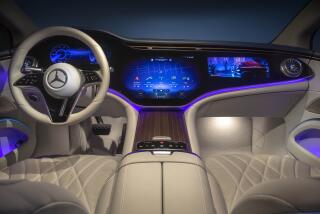Auto Makers Taking High-Tech Road
Led by Cadillac, Jaguar and a pair of innovative suppliers, the auto industry is serving up some dazzling electronic gadgetry.
They range from rear-seat entertainment systems--so kids can watch DVDs or play video games--to a dashboard unit that allows drivers to play audio CDs and CD-ROMs, use flash memory cards, play MP3 music files, access computerized address books and make phone calls with a voice-activated system. Thereâs also a night vision system, hundreds of channels of satellite radio, a private safety alert system and a port to connect Palm computer devices to cell phones.
Much of this technology revolves around âtelematics,â or multimedia communications with vehicles. Think of it as combining driving, telecommunications, satellite navigation and surfing the Web. Itâs the next horizon of automotive technology, says Saul Rubin, an auto industry analyst at UBS Warburg in New York.
General Motors has offered its OnStar system since 1996 and is considered the industry leader in telematic devices. For a $199 annual fee, the OnStar system establishes a phone link between the vehicle and OnStarâs dispatch center when the carâs air bags are deployed, notifying police and ambulance services. For $399 a year, OnStar offers a concierge service with operators that make restaurant and theater reservations, unlock cars remotely when drivers get locked out and make a carâs lights flash and its horn honk when its owner canât find it in, say, Dodger Stadiumâs parking lot.
OnStar will be available in about 30 GM models by yearâs end, including Buicks, Oldsmobiles, Pontiacs and Chevrolets. Cadillac purchasers get one year of OnStar service free, but in other models consumers have to pay $17 to $35 a month for the service.
GM is ahead in consumer applications of telematics, according to Rubin. âGMâs problem might be that itâs trying to push an expensive system,â he said.
Much of the newest high-tech gadgetry revolves around voice-activation capability. A $4,300 voice-recognition system offered in the Jaguar S-Type four-door sedan allows drivers to dictate to the car what radio station to play, what cabin temperature to set and which cell phone number to dial.
By yearâs end, OnStarâs Virtual Advisor will be on the market. It will fetch e-mail and read it to you, and it can dictate weather, stock, news and sports reports. Users will buy prepaid minutes for its use; access fees have not yet been decided. Customers create a profile on an OnStar Web site specifying the information they want to receive.
In a GM demonstration last week, the Virtual Advisor worked well, reading financial data, such as the closing Dow Jones average and stock quotes. It read a couple of e-mails in a choppy, robotic male voice and on request played prerecorded roundups on baseball and football and a separate report on the Denver Broncos.
The only glitch in this demonstration came when a request to âget my weatherâ caused the system to freeze up. But the womanâs voice that delivered the weather on a second try was smooth.
A much more impressive device is Cadillacâs Infotainment system, a $2,000, in-dashboard unit available in the 2001 DeVille and Seville models. The system allows passengers to play CDs, CD-ROMs, MP3 files, access an on-board computerized address book and respond to e-mail via the systemâs Windows CE operating system. Car occupants can make and receive hands-free, voice-activated phone calls; hear news, stock quotes, weather and sports scores; exchange data with hand-held computers through an infrared port; and even record 15 minutes of voice memos.
The Infotainment system is made by Delphi Automotive, GMâs former parts unit that was spun off last year.
Delphi also has a product coming out this year for use with Palm hand-held computer devices. The Mobile Productivity Center is a Palm docking station that fits in a cup holder and holds a cell phone linked to the Palm. Drivers use their voice to instruct the system to download data to the Palm, such as e-mail, news and financial information.
Delphiâs biggest competitor, Visteon Corp., once a Ford parts unit, makes the Rescu system. Used in Lincolns, it is similar to OnStar, offering emergency notification when an air bag deploys.
Visteonâs ICES product--for information, communication, entertainment, safety and security--is similar to a toned-down Delphi Infotainment unit. It also fits in the dashboard and can make cellular calls, connect to the Internet and fetch e-mail from corporate and personal accounts. But for now, ICES will probably only be installed in rental and corporate car fleets.
Visteon is experimenting with Texas Instruments to produce an instrument panel that drivers can reconfigure to put the speedometer, odometer, gas and temperature gauges where they want. It is also working on a âbabe watchâ function that inserts a camera image on the dashboard to enable parents to keep an eye on a child in the back seat.
System Lets Drivers See Beyond Headlights
One of the most impressive gadgets is Cadillacâs night vision system, a $1,995 option in the DeVille. The system, introduced last year, is based on Persian Gulf War technology from Raytheon and uses infrared thermal imaging to enable drivers to see beyond the range of their headlights. People and animals that would not be visible in the dark show up as white figures on a small display on the windshield. The images are placed within the driverâs peripheral vision so eyes can stay focused on the road.
DaimlerChrysler has been slow to introduce similar gadgetry, although Rubin expects product developments in the near future. The companyâs experimental ESX-3 sedan is an intriguing mock-up. Itâs outfitted with an infrared port to communicate with a hand-held computer running Windows CE. A computer wasnât built into the car, because computer technology changes much faster than car models, which last around four years. Similarly, the concept MaxxCab pickup truck has a docking station for a laptop computer to allow e-mail transmission and exchange data with the truck. But being concept cars, these systems are far from the production stage.
For drivers who crave talk and tunes, rivals XM Radio and Sirius are developing satellite radio systems that by next year will provide cable TV-like choices of music channels. The two are offering competing but similar systems. Sirius has Ford and DaimlerChrysler as major investors and will start broadcasting early next year; XM Radio is backed heavily by GM and will launch in mid-2001. Both systems will cost $9.95 a month. Sony, Pioneer and Alpine will be making car and home audio sets to receive the 100 channels that each will provide.
Programming will range from rock to classical, evangelical and big-band music and talk shows. âItâs hard to find country-western in the Northeast, religious broadcasting outside of the South or Hispanic shows in the North,â says XM Radio Vice President Dan Murphy. âWeâll offer it all, 24 hours a day, so you wonât be listening to music based on your geographic location.â
Not all in-vehicle tech wizardry is telematics-based. Already some Mercedes, Jaguar, Toyota and Ford models offer âadaptive cruise control,â which automatically keeps your auto a safe distance from other cars by using radar to sense vehicles in front. If you get too close while in cruise control mode, the engine slows down. And rear-parking-assist technology--which beep warnings when a car is backing up too close to an object--is starting to show up in vehicles such as the DeVille, Jaguar, Fordâs Windstar van and even the Taurus.
Also appearing are rear-seat entertainment systems that hook up a VCR and video game to a TV screen and are designed mainly to relieve kidsâ boredom in the back seats of minivans on long trips. These rear entertainment systems are offered as options by most minivan makers in at least one of their models, usually for $1,500 to $2,000. Such systems are standard in the latest Nissan Quest minivan. And Delphi and Visteon both make systems for the aftermarket for $1,500 to $2,000.
Parents may soon be hearing less of âAre we there yet?â and more of âCan we finish the movie first?â
(BEGIN TEXT OF INFOBOX / INFOGRAPHIC)
Car Gadgets
The next wave of automotive technology is bringing more entertainment and Internet devices to cars. Some are fun and games, some are all business and others are designed with safety in mind, including voice-activated devices.
Source: Times research






